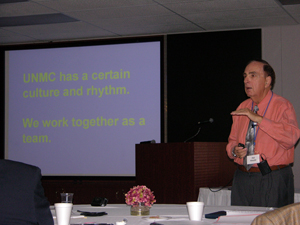 |
UNMC Chancellor Harold M. Maurer, M.D., stresses a point during Wednesday’s annual strategic planning retreat at the Westside Community Center. |
The medical center must grow its research capabilities in areas of advanced science such as regenerative medicine and bioinformatics to achieve world class status as an academic health sciences center, UNMC Chancellor Harold M. Maurer, M.D., said during opening comments.
“These areas represent the future of biomedical research and it’s vital that we engage and excel in such fields,” Dr. Maurer said.
The term regenerative medicine refers to innovative medical therapies that enable the body to repair, replace, restore and regenerate damaged or diseased cells, tissues and organs. The term encompasses several research areas including cell therapy, tissue engineering, biomaterials engineering, growth factors and transplantation science.
|
A panel discussion on regenerative medicine featured comments from Paul Simmons, Ph.D., director of the Center for Stem Cell Biology at the University of Texas Health Science Center in Houston — a world-renowned expert on regenerative medicine.
UNMC faces many challenges in forming a regenerative medicine center, he said, noting that developments in the field come fast and competition for top scientists is fierce. But face these challenges UNMC must if it wishes to thrive in the world of biomedical research, Dr. Simmons said.
Dr. Simmons said that if UNMC decides to form a regenerative medicine center, medical center leaders should:
- Create a physical structure to house the center;
- Let the center serve as an educational resource that provides objective information on regenerative medicine; and
- Garner the significant philanthropic support needed to attract the quality scientists needed to do the work.
Dr. Simmons also said UNMC should focus its regenerative medicine research in ways that will most benefit Nebraskans.
“The world of regenerative medicine is an exciting place but it also is fast paced and highly-competitive,” Dr. Simmons said. “You will need strong leadership to make this happen but I think you can accomplish great things if you can bring it all together.”
Omaha community leader Richard Holland joined Dr. Simmons on the panel. He said it’s important for UNMC to educate the public of the great promise regenerative medicine holds.
“You need to let people know that this work is aimed at saving and improving lives,” Holland said.
Another panel discussion focused on bioinformatics and featured Ary Goldberger, M.D., a professor of medicine at Harvard University Medical School.
Bioinformatics is the use of information technology to store, organize and study biological information.
Dr. Goldberger oversees a database called PhysioNet that stores large amounts of data from EKGs and other medical readings. Scientists from around the world have used information from PhysioNet to advance their research.
During his presentation, Dr. Goldberger encouraged UNMC to strengthen its efforts in bioinformatics.
“UNMC is in good position to improve its bioinformatics efforts,” he said. “The work being done by scientists here and the knowledge base of those scientists is very valuable and could help investigators at UNMC and elsewhere.”
To improve bioinformatics at UNMC, the medical center must create policies and procedures for data sharing that will be utilized by researchers in different colleges, departments and disciplines, said Simon Sherman, Ph.D., director of the Bioinformatics Shared Resources at UNMC.
This will help create a common language that will allow UNMC researchers to collaborate with researchers on campus and beyond, Dr. Sherman said.
And increased cooperation across disciplines and improved bioinformatics infrastructure are required if UNMC wishes to receive major grants including a Clinical and Translational Science Award from the National Institutes of Health, said Jennifer Larsen, M.D., associate dean for clinical research in the College of Medicine, who joined Dr. Goldberger on the panel.
UNMC must become better in bioinformatics research to achieve world-class status, said Ken Cowan, M.D., Ph.D., director of the UNMC Eppley Cancer Center.
“Bioinformatics research is a key element for the future success of any medical center,” Dr. Cowan said.
|
|
Vice Chancellor for External Affairs Bob Bartee — who also is a member of the Chancellor’s Council — concurred with Dr. Cowan’s sentiments about the retreat and made special mention of the efforts of Dr. Maurer and John Adams, Ph.D., assistant vice chancellor for budget and strategic planning.
“Every year, exciting ideas and developments are conceived at this retreat and that was certainly the case this year, too,” Bartee said. “Once again Drs. Maurer and Adams did a wonderful job of making this event productive and special.”